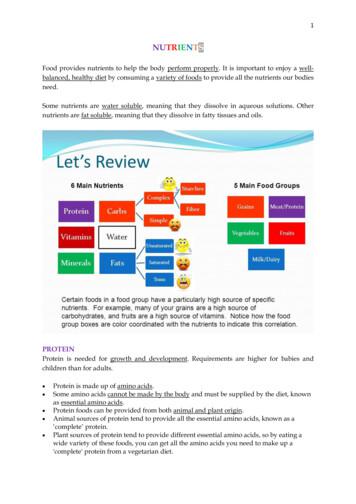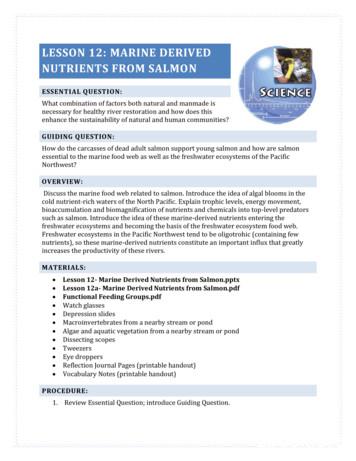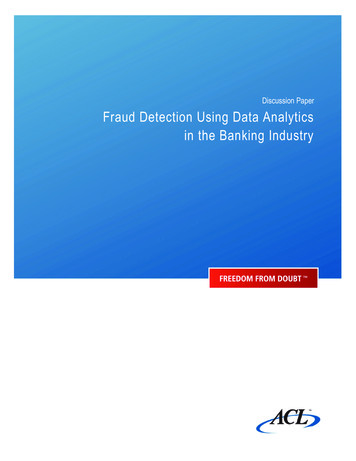Supplementing Dietary Nutrients - Point Institute
Supplementing Dietary NutrientsA Guide for Healthcare ProfessionalsSECOND EDITIONDefining Optimal Nutrition Nutrients as Genomic & Epigenetic Signals Protein SupplementationFatty Acid Supplements Vitamin Sources & Forms Mineral Sources & FormsNatural vs. Synthetic Vitamins Whole Food vs. Isolates Choosing a ProbioticBotanical & Phytonutrient Basics Fundamentals of Dietary Supplement RegulationsDeciphering Supplement Labels Prenatal Supplementation And Much More .Thomas G. Guilliams Ph.D.Foreword by Jeffrey Bland, Ph.D.
Disclaimer: This publication is intended only to inform and educate healthcare professionals; and combines both establishedand emerging nutritional information. The scope of this publication is limited and is not intended to replace the role ofcomprehensive textbooks on nutrition. Nothing herein is intended to replace guideline recommendations or promote specifictherapies for individual patients. Healthcare providers are responsible to make their own determination of the usefulnessand applicability of the information within this publication. Neither the publisher, author, nor reviewers assume any liabilityfor any injury to persons arising from the use of the information found in this publication. 2020 Thomas G. Guilliams. Printed and bound in the United States of America. All rights reserved.No part of this book may be reproduced or transmitted in any form or by any means, electronic or mechanical,including photocopying, recording, or by an information storage and retrieval system—except by a reviewer whomay quote brief passages in a review to be printed in a magazine, newspaper, or on the Web—without permission inwriting from the publisher. For information, please contact the Point Institute at info@pointinstitute.org.Although the author and publisher have made every effort to ensure the accuracy and completeness of informationcontained in this book, we assume no responsibility for errors, inaccuracies, omissions, or any inconsistency herein.Any slighting of people, places, or organizations is unintentional.ISBN: S,COLLEGES,ANDPROFESSIONALORGANIZATIONS: Quantity discounts are available on bulk purchases of this book for educational or giftpurposes, or as premiums for increasing magazine subscriptions or renewals. Special books or book excerpts can alsobe created to fit specific needs. For information, please contact the Point Institute at info@pointinstitute.org.
ForewordI have been involved as a researcher and educator in personalized nutrition and dietarysupplementation for the past forty years. Over these decades, the basic and clinical sciencesthat describe the mechanism of action of various micronutrients and their role in supportingfunctional physiology has evolved in both quantity and quality. With the development ofnutrigenomics in the early 21st century the field exploded with new information; advances whichwere then closely followed by the developing understanding of nutritional epigenetics. It haschallenged those in the field to keep up with all these advances without losing the foundationalknowledge that had been historically developed surrounding the role of various dietarysupplements in health and disease prevention since their discovery in the early 20th century.It takes a remarkable person to undertake writing a comprehensive review that can serve as aresource guide for this extensive body of information. A person with great attention to detail,who understands human biochemistry and the role that nutrients play in its function, and whohas the ability to look back and forward in the development of the wisdom that has been gainedthrough the work of countless researchers and clinicians concerning the importance of dietarysupplements in both personal and population health.This is why the book Supplementing Dietary Nutrients-A Guide for Healthcare Professionalsneeded to be authored by a professional such as Dr. Thomas Guilliams, who fulfills all ofthese criteria. Dr. Guilliams is a nutrition researcher, educator, thought-leader, and trustedauthority providing balanced information for health professionals on the appropriate use ofdietary supplements in personalized health care. His decades of experience serves well in theway he has approached the organization and content of this amazing encyclopedia of ''news touse''concerning dietary supplements.This is a reference book that should be in the library of any health professional that has aninterest in dietary supplements and their application to personalized health care. There is atimeless quality to this book, in the way that the information is presented and the documentationand support that underlies its content. The future will bring new discoveries and informationon the role and application of dietary supplements in health care, but the content of this bookprovides a review of the core concepts and logic that defies age and will be useful for decades tocome.This book is truly a treasure for those who own it, in that it saves hours of searching for valuableinformation concerning the portfolio of nutrients that are included under the definitionof dietary supplements. Dr. Guilliams has done us all a great favor in assembling this expansivebody of information on dietary supplements and their clinical application in personalized healthcare.Jeffrey Bland Ph.D.Founder & President, Personalized Lifestyle Medicine Institute
TABLE OF CONTENTS7Table of ContentsLifestyle-Based Therapy – Our Core Philosophy . 12The Seven Spheres of Lifestyle Signals .12Physiological Resilience and Metabolic Reserve .13Hierarchy of Lifestyle Therapies . 15Prevention to Intervention Hierarchy . 16Building Metabolic Reserve Through Diet and Supplementation .18A Healthy Dietary Pattern (e.g., The Mediterranean Diet) . 18Diversity: Good for You and Your Gut Microbiome . 18The Functions and Signaling Capacity of Essential Nutrients .19Genomic and Epigenetic Signaling of Nutrients .19Chrononutrition: Nutrient Signals and Circadian Rhythm .20Circadian Regulation of Metabolism .20The Epigenetic Influence of Nutrients .22The Mechanism and Biological Functions of Vitamin D.23Nutrigenetics and the Application of Personalized Nutrition.24Optimal Nutrition: How is it Defined – Can It Be Achieved? . 26Defining Nutrient Intake vs. Status .26Intake Guidelines Defined .28The Relationship Between the IOM’s DRIs and the FDA's DVs.28Assessing the Nutrient Status of a Patient .30Populations Vulnerable to Nutrient Status Insufficiencies . 31Prenatal Dietary and Supplemental Approaches . 36Nutrition and Pregnancy Outcomes in Developed Countries .36Recommended Gestational Weight Gains. 37Dietary Patterns and Recommendations for Successful Pregnancies . 37Macronutrient Recommendations. 37Micronutrient Recommendations .39Folates/Folic Acid .40Choline and Related Methylation Support . 41Vitamin B12 .42Iron .42Iodine .43Vitamin D .43Vitamin A .43Should Prenatal Supplements be Recommended to All Pregnant Women?.44Achieving Adherence to Prenatal Supplementation .44Gut Microbiota and the Role of Probiotics During Pregnancy .44Comparing Nutrient Forms: When are They Clinically Meaningful? .48Synthetic vs. Natural Vitamins .48Nutrients from Food or Supplements: Which is Better? .49Provitamins and Activated Forms .50Assessing the Claims of ''whole-food'' Supplements .50Are Mineral Supplements Natural? . 52Supplementing Dietary Nutrients: A Guide for Healthcare ProfessionalsPoint Institute
8TABLE OF CONTENTSSupplementing Macronutrients .54Proteins .54Intake Guidelines .54Determining Protein Quality . 55Supplemental Protein Sources . 55Amino Acid Supplementation vs. Dietary Protein .56Allergies, Sensitivities and Preferences .56Carbohydrates.58Intake Guidelines .58Carbs in Context.58Artificial and Natural Non-Nutritive Sweeteners.59Artificial Sweeteners and the Microbiome . 61A Balanced Approach to Sweeteners in Supplements .62Fiber .63Intake Guidelines .63Supplemental Fiber/Functional Foods .64Fatty Acids .66Intake Guidelines .66Fatty Acid Structures and Functions .66Fatty Acid Primer . 67Supplementing Omega-3 Fatty Acids .69Supplementing Omega-9 Fatty Acids . 74Supplementing Omega-6 Fatty Acids . 74Water . 76Is There a Measure of Proper Hydration? . 76Intake Recommendations . 76Supplementing Micronutrients (How to Read the Monographs) . 79Vitamin Monographs .80Vitamin A .80Vitamin B1 (Thiamin) .86Vitamin B2 (Riboflavin) . 91Vitamin B3 (Niacin).96Vitamin B5 (Pantothenic Acid) .100Vitamin B6 (Pyridoxine) .105Vitamin B7 (Biotin). 112Vitamin B9 (Folic Acid, Folate, 5-MTHF) . 116Vitamin B12 (Cobalamin).124Vitamin C .134Vitamin D .139Vitamin E .148Vitamin K . 157Mineral Monographs .166Calcium .166Chromium .172Copper . 177Iodine .182Iron .186Magnesium .194Manganese . 200Molybdenum .203Phosphorus .207Potassium . 211Supplementing Dietary Nutrients: A Guide for Healthcare ProfessionalsPoint Institute
TABLE OF CONTENTS9Selenium. 216Zinc . 221Functionally Essential Nutrients .228Carnitine .228Carotenoids .234Choline .240Coenzyme Q10 .245Inositol.256Lipoic Acid.259Supplementing Antioxidants . 263Reactive Molecules and Their Biological Roles .263Antioxidants: Reversing Oxidation and Quenching Free Radicals .264Endogenous vs. Exogenous .264Redox Antioxidants.264ORAC Values .264Glutathione.265Enzyme Antioxidants .266Genomic Antioxidants .266Nrf2 Activation: A Key Regulator of Antioxidants .267Pros and Cons of Supplementing Antioxidants.269Herbals, Botanicals, and Phytonutrients: The Basics . 271Herbal Medicines vs. Botanical Ingredients . 271Herbal Preparations for Oral Consumption . 271General Preparations of Botanical Products .272Issues Unique to Botanical Products .273How Do You Know You Have the Right Plant? .273Adulteration and Contamination of Botanicals . 274Sources of Concentrated Phytonutrients . 274Synthetic Botanical Ingredients . 274The Phytochemical Bioavailability Conundrum . 276Curcuminoids from Turmeric: A Precautionary Tale . 276Curcumin’s Bioactive Compounds . 276Pharmacokinetics of Curcuminoids . 277Comparative Bioactivity of Enhanced Curcumin .279The Emerging Role of Gut Microbiota .279Berberine and the Gut Microbiota: A Bidirectional Relationship .280Beyond Curcumin: The Other Bioactives in Turmeric. 281A Way Forward . 281The Trend Beyond Curcumin .282Probiotics.
Drug-Induced Nutrient Depletion Chart .318. 20 BUILDING METABOLIC RESERVE THROUGH DIET AND SUPPLEMENTATION Supplementing Dietary Nutrients: A Guide for Healthcare Professionals Point Institute Chrononutrition: Nutrient Signals and Circadian Rhythm Sy
Drug-Induced Nutrient Depletion Chart . 318. 16 lIFesTyle-bAseD THeRAPy: oUR CoRe PHIlosoPHy supplementing Dietary nutrients: A Guide for Healthcare Professionals Point Institute R e s c u e L I n t e r v e
Lesson 2: Nutrients We Need 29 2. Nutrients We Need. OBJECTIVES . To emphasize the similarities between humans and plants in the need for nutrients To learn about the six classes of nutrients and why we need all six of them To learn how to identify good food sources of selected nutrients To learn how plants provide us with nutrients
NUTRIENTS Food provides nutrients to help the body perform properly. It is important to enjoy a well-balanced, healthy diet by consuming a variety of foods to provide all the nutrients our bodies need. Some nutrients are water soluble, meaning that they dissolve in aqueous solutions. Other
Marine-derived nutrients (MDN)-Nutrients acquired by an anadromous fish and deposited in a freshwater or terrestrial ecosystem when that fish dies. Oligotrophic- Containing few nutrients and therefore unable to support much life . Eutrophic- An ecosystem containing high levels of nutrients and therefore supporting
Manure contains both macro- and micro-nutrients needed for crop production in organic and inorganic forms. Inorganic nutrients are readily available to the growing crop, while the organic nutrients become available gradually over time. A crop responds to inorganic nutrients in soil, whether they originate from manure or commercial fertilizer.
Module - Classes of Nutrients Learning Objectives Beginner List the five classes of nutrients. Identify common sources for each nutrient. Intermediate Explain functions of common nutrients in horses. Discuss the difference between micro- and macro-nutrients. Seniors Discuss the concept of "most limiting nutrient."
Keywords: iron, folate, zinc, dietary supplement, diet, nutrition, pregnancy Introduction Adequate amounts of nutrients during pregnancy are essential for maternal, fetal and child health. However, few population-based studies have examined dietary intake and use of dietary supplements among pregnant women in Canada. Of particular
Fraud Detection Using Data Analytics in the Banking Industry 5 Banking Fraud detection in banking is a critical activity that can span a series of fraud schemes and fraudulent activity from bank employees and customers alike. Since banking is a relatively highly regulated industry, there are also a number of external compliance requirements that banks must adhere to in the combat against .





















